Board Meeting
 San Juan Sailing Club
San Juan Sailing Club
This is the Blog of the San Juan Sailing Club. It contains notices of upcoming events, pictures and descriptions of past events and informational articles. All of its content is submitted by our members. Any submissions are welcomed and encouraged. The more content that is posted, the more informative and fun this will be for all of us.
My daughter Brittany and I spent 10 days a few weeks ago helping rebuild a home after Katrina and thought you would like to see the New Orleans Yacht club 1 year later. Still no power or plan to fix the marina or even haul off the destroyed yachts. Believe me the devastation is mind boggling. So many beautiful sailing vessles splintered and piled.





I watched the start of the He-Man Cup and took a few pictures.
 There was a bit of controversy at the start; always important in any sailing race. The question was whether Dorman crossed the line early. This picture was taken just as the gun went off and should settle the issue.
There was a bit of controversy at the start; always important in any sailing race. The question was whether Dorman crossed the line early. This picture was taken just as the gun went off and should settle the issue. David and Janet in the lead after about a mile.
David and Janet in the lead after about a mile. Buz and crew catching up.
Buz and crew catching up. Phil doing it solo.
Phil doing it solo.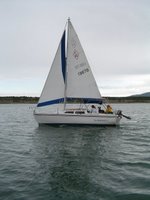 Kari and Perry Pepper settling in for the long haul.
Kari and Perry Pepper settling in for the long haul.Hopefully the participants will share some of the details about their race with us.
Fred GrimesHello sailing friends,
 In our class of 38 boats, all were much faster than our tiny Olson 30. We were competing against Farr 40s, Columbia 50s, Soverrel 33, J36...C&C46, and other Olson 30s. We were the slowest boat in the fleet (PHRF F). For our start, the right side of the line was favored and we hit it full speed 3 feet back at the gun, 6-8 knots of wind on the nose and boat speed of 6 knots, a good start. (Last year we were over a foot and had our spinnaker up and powered before the call back.(poor committee work) so we had to do a drop / jib hoist / sail back and restart and still managed a second place.)
In our class of 38 boats, all were much faster than our tiny Olson 30. We were competing against Farr 40s, Columbia 50s, Soverrel 33, J36...C&C46, and other Olson 30s. We were the slowest boat in the fleet (PHRF F). For our start, the right side of the line was favored and we hit it full speed 3 feet back at the gun, 6-8 knots of wind on the nose and boat speed of 6 knots, a good start. (Last year we were over a foot and had our spinnaker up and powered before the call back.(poor committee work) so we had to do a drop / jib hoist / sail back and restart and still managed a second place.) This year was a year of hardly any wind. Our top speed was 10.8 knots GPS, pretty tame compared to other years when I've seen our boat speed hit 22 knots for mile after mile. But light air sailing will separate the men from the boys and being the hot team we had (Skipper, Cole Price, won over 120 trophies: Pit, George, 2 time national champion: Trimmer, Stew, 2nd at Worlds Snipes: Foredeck, Mike, 16 years old Coles son: Paul, national champ, lasers: and myself, Buz Branch, Hick from the sticks: Crew chief, driver, rail meat, and trimmer.) The team work was awesome.
This year was a year of hardly any wind. Our top speed was 10.8 knots GPS, pretty tame compared to other years when I've seen our boat speed hit 22 knots for mile after mile. But light air sailing will separate the men from the boys and being the hot team we had (Skipper, Cole Price, won over 120 trophies: Pit, George, 2 time national champion: Trimmer, Stew, 2nd at Worlds Snipes: Foredeck, Mike, 16 years old Coles son: Paul, national champ, lasers: and myself, Buz Branch, Hick from the sticks: Crew chief, driver, rail meat, and trimmer.) The team work was awesome. The night was cold, wet, sleepless, no moon, dark clouds and not one star to steer by...Next morning, we saw we were in the company of "A fleet" yachts that started an hour ahead of us so we were feeling pretty good about the "night fight "We saw 1 whale and 100s of dolphins (which had given us an escort all night). As the wind picked up during the day, we surfed the big swells rolling down from Alaska. We finished just as the sun set and the wind completely shut off. I felt sorry for the racers that were still out as they had another long night (you could look out and see literally 100s on the horizon).
The night was cold, wet, sleepless, no moon, dark clouds and not one star to steer by...Next morning, we saw we were in the company of "A fleet" yachts that started an hour ahead of us so we were feeling pretty good about the "night fight "We saw 1 whale and 100s of dolphins (which had given us an escort all night). As the wind picked up during the day, we surfed the big swells rolling down from Alaska. We finished just as the sun set and the wind completely shut off. I felt sorry for the racers that were still out as they had another long night (you could look out and see literally 100s on the horizon). We were 2nd over the finish line to claim the #2 trophy (or first to lose is how we look at it). We were happy as we had passed Shock 35s, J boats, a Reynolds 38 and lots of other very fast boats. Only a Columbia 50 beat us across the finish line (said he found wind 50 miles out) to just barely correct to first. Our corrected time put us in the top 10% of finishers for the whole regatta. We have trophied the past 5 out of six years in this regatta but have never gotten a first...yet....
We were 2nd over the finish line to claim the #2 trophy (or first to lose is how we look at it). We were happy as we had passed Shock 35s, J boats, a Reynolds 38 and lots of other very fast boats. Only a Columbia 50 beat us across the finish line (said he found wind 50 miles out) to just barely correct to first. Our corrected time put us in the top 10% of finishers for the whole regatta. We have trophied the past 5 out of six years in this regatta but have never gotten a first...yet....All--
Seats-of-Ease
“If you want to relieve yourself . . . you have to hang out over the sea like a cat-burglar clinging to a wall. You have to placate the sun and its twelve signs, the moon and the other planets, commend yourself to all of them, and take a firm grip of the wooden horse’s mane; for if you let go, he will throw you and you will never ride him again. The perilous perch and the splashing of the sea are both discouraging to your purpose, and your only hope is to dose yourself with purgatives.”
Eugenio de Salazar, 1573
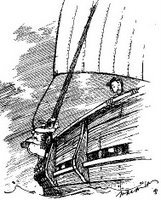 This tongue-in-cheek passage vividly describes what it was like for one passenger to relieve himself (go to the bathroom) on a Spanish sailing ship during a sixteenth-century trans-Atlantic voyage. Obviously, this man felt the need to humorously describe what was otherwise considered a basic bodily function that was not frequently written about then—or today, for that matter. It’s a good thing he did feel like writing about it, because it is one of only a very few firsthand descriptions from that or any other period of what going to the bathroom was like on historic sailing ships.
This tongue-in-cheek passage vividly describes what it was like for one passenger to relieve himself (go to the bathroom) on a Spanish sailing ship during a sixteenth-century trans-Atlantic voyage. Obviously, this man felt the need to humorously describe what was otherwise considered a basic bodily function that was not frequently written about then—or today, for that matter. It’s a good thing he did feel like writing about it, because it is one of only a very few firsthand descriptions from that or any other period of what going to the bathroom was like on historic sailing ships.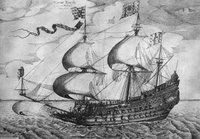 Because of their very nature, waterborne craft have usually been able to accommodate the “human need.” By simply eliminating human wastes directly into the sea or by throwing collected materials overboard, shipboard occupants established an efficient, common-sense disposal scheme.
Because of their very nature, waterborne craft have usually been able to accommodate the “human need.” By simply eliminating human wastes directly into the sea or by throwing collected materials overboard, shipboard occupants established an efficient, common-sense disposal scheme. 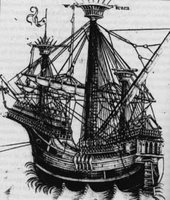 Conscious attempts to improve the unhealthy interior conditions resulted in the development of external waste-disposal accommodations. Any amount of human wastes eliminated directly into the sea, rather than to the interior of the hull, was advantageous, at least in terms of sight and smell, even if the connection between filth and disease that we appreciate today was not then understood.
Conscious attempts to improve the unhealthy interior conditions resulted in the development of external waste-disposal accommodations. Any amount of human wastes eliminated directly into the sea, rather than to the interior of the hull, was advantageous, at least in terms of sight and smell, even if the connection between filth and disease that we appreciate today was not then understood. Evidence of hygienic conveniences in the projecting bow structures (beakheads, or “heads”—the origin of the common name of ships’ toilets) of ships of the fifteenth and sixteenth centuries is sketchy. Wooden gratings, slots in the flooring, rails of the beakhead, and simple, holed boards as seats have all been suggested as having served a hygienic, waste-disposal function during the fifteenth and sixteenth centuries.
Evidence of hygienic conveniences in the projecting bow structures (beakheads, or “heads”—the origin of the common name of ships’ toilets) of ships of the fifteenth and sixteenth centuries is sketchy. Wooden gratings, slots in the flooring, rails of the beakhead, and simple, holed boards as seats have all been suggested as having served a hygienic, waste-disposal function during the fifteenth and sixteenth centuries. In 1628, the Swedish warship Vasa (or Wasa) sank suddenly in Stockholm harbor. She was located and successfully recovered in the late 1960s/early 1970s; conservation (stabilization) of the magnificently preserved wood took more than 20 years to accomplish. The wooden timbers of the ship and numerous other organic artifacts were well preserved due to the cold temperatures and low oxygen content of the waters at the bottom of Stockholm harbor. Two beautiful examples of nearly complete free-standing seats-of-ease were
In 1628, the Swedish warship Vasa (or Wasa) sank suddenly in Stockholm harbor. She was located and successfully recovered in the late 1960s/early 1970s; conservation (stabilization) of the magnificently preserved wood took more than 20 years to accomplish. The wooden timbers of the ship and numerous other organic artifacts were well preserved due to the cold temperatures and low oxygen content of the waters at the bottom of Stockholm harbor. Two beautiful examples of nearly complete free-standing seats-of-ease were 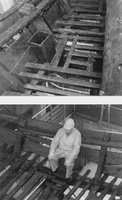 discovered in the beakhead of the Wasa. A Wasa Museum employee demonstrates the correct orientation of the user on these early seventeenth-century hygienic accommodations; they were simple, but quite effective, devices.
discovered in the beakhead of the Wasa. A Wasa Museum employee demonstrates the correct orientation of the user on these early seventeenth-century hygienic accommodations; they were simple, but quite effective, devices.The Commodore’s Corner


By now, you have all probably read about the Progressive Brunch to be held on Sunday, September 3rd.
It has come to my attention, through David, that Buz and his elder daughter, Brittany, have been spending quite some time in New Orleans helping with the Katrina relief effort. Hopefully we will get an account of their experience in this admirable and generous effort.
We would like to publicly express our gratitude toward the helpfulness of the club members. We especially appreciate David and Janet Dickinson and Buz Branch, whose advice and generosity has allowed us to pick up our dad's boat and begin our own adventures where he left off at his passing. Without their support, his gift to us would have been lost in our ignorance of the complexity of a few systems. It has been such a wonderful experience and we treasure it every weekend. It is as much a gift from you as it is from dad.
Here is the revised Schedule: